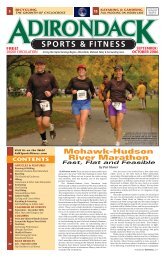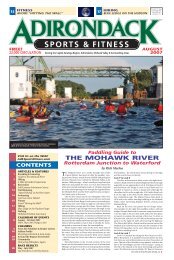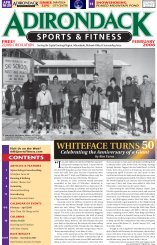Kids Running - Adirondack Sports & Fitness
Kids Running - Adirondack Sports & Fitness
Kids Running - Adirondack Sports & Fitness
You also want an ePaper? Increase the reach of your titles
YUMPU automatically turns print PDFs into web optimized ePapers that Google loves.
8 <strong>Adirondack</strong> <strong>Sports</strong> & <strong>Fitness</strong><br />
NUTRITION<br />
WOMEN’S HEALTH INITIATIVE STUDY<br />
Staying on Track with Healthy Eating after<br />
Reading these Results<br />
The headlines are big but the message<br />
has been very poorly brought to the<br />
consumers. If you’ve read the newspapers<br />
and heard the news in February<br />
this is what you would have heard:<br />
1) According to the latest clinical trial<br />
results from the Women’s Health Initiative<br />
study, a low fat diet does not significantly<br />
reduce the incidence of breast cancer,<br />
heart disease or stroke, nor did it reduce<br />
the risk of colorectal cancer in healthy<br />
postmenopausal women, and 2) Calcium<br />
and vitamin D supplements in healthy<br />
postmenopausal women provide a modest<br />
benefit in preserving bone mass and<br />
preventing hip fractures in certain groups<br />
including older women but do not prevent<br />
other types of fractures or colorectal<br />
cancer, according to a major clinical trial<br />
in the Women’s Health Initiative.<br />
The first trial on low fat diets consisted<br />
of 48,835 women aged 50-79 at trial<br />
enrollment and were followed for an average<br />
of 8.1 years. The study only focused<br />
on reducing total fat. Women in both<br />
groups started at 35 to 38 percent total fat.<br />
By the end of the first year, the low fat<br />
group averaged 24 percent of calories<br />
from fat but did not meet the study goal of<br />
20 percent. At year six the low fat group<br />
was consuming 29 percent of calories<br />
from fat. The comparison group averaged<br />
35 percent fat in year one and 37 percent<br />
at year six. The low fat diet group also<br />
increased their consumption of fruits vegetables<br />
and grains.<br />
We know too much about foods now to<br />
think that just a reduction of total fat<br />
would and could make a big difference all<br />
by itself. It is the type of fats we use, not<br />
only the amount that make a difference. It<br />
is whole grains and less processed grains<br />
that count. It is the amount and color<br />
choices of fruits and vegetables, and not<br />
just eating fruits and vegetables that matter.<br />
The key is more nutrient dense whole<br />
foods and less candy, white flour, sugar,<br />
processed carbohydrates and fats, and<br />
soda. And now we also know that C-reactive<br />
protein, a component of the blood<br />
that is an indicator of the amount of<br />
inflammation, is also a tool used to indicate<br />
the risk of disease. Diet may play a<br />
part in reducing this risk.<br />
The biggest problem with this study is<br />
that participants did not make significant<br />
KAYAKS & CANOES<br />
Sales • Rentals • Lessons • Tours<br />
Great Selection of Accessories<br />
& Paddlewear for the Enthusiast<br />
•<br />
Sprayskirts & Cockpit Covers<br />
to Fit Most Brands<br />
•<br />
Car & Truck Racks<br />
2123 CENTRAL AVENUE (RTE. 5)<br />
COLONIE, NY · (518) 346-3180<br />
4.25 MILES WEST OF NORTHWAY EXIT 2W<br />
OneWithWater.com<br />
by Sabine Weber<br />
enough changes to promote the results<br />
that I believe they could have been seen<br />
with diet alteration. The participants had<br />
numerous sessions with a dietitian, but<br />
changes made were not profound enough<br />
to make a difference and really think past<br />
a low fat diet.<br />
Another big problem with this study is<br />
that it did not control the type of fat used<br />
by the participants. In short, participants<br />
were allowed to eat any type of fat they<br />
desired, so long as the amount of fat they<br />
ate fell within the required limits. There<br />
was no comparison made between good<br />
fats and bad fats. The lower fat group could<br />
have received much of their 29 percent<br />
from processed fats providing trans fats<br />
and saturated fats. There was no emphasis<br />
on using beneficial fats from fish, nuts and<br />
seeds, flax and certain vegetable oils. All<br />
well promoted to reduce disease.<br />
Phytochemicals in foods are now better<br />
researched and recognized as being<br />
beneficial to control disease. (Refresher:<br />
phytochemicals are plant chemicals<br />
which protect the plants against damage<br />
from oxygen radicals, a viral attack, harsh<br />
weather and improper handling, and<br />
which may act similarly in the body by<br />
blocking cancerous substances, protecting<br />
the body against cell damage from<br />
oxidation and stopping tumor growth.)<br />
The increase in fruits and vegetables in<br />
the study was only an average of 1.1 servings<br />
per day per person. Adding a large<br />
apple or banana a day could have made<br />
this difference insignificant. This is not<br />
enough if you are looking at overall<br />
decrease in disease.<br />
Many organizations now recommend<br />
more fruits and vegetables than we once<br />
thought. The “five-a-day” program that<br />
suggested eating five helpings of fruits<br />
and vegetables daily is now recommending<br />
five to nine a day. The emphasis<br />
should be to increase the intake of fruits<br />
and vegetables with deep rich colors like<br />
orange, blue, red and green, since plants<br />
with these colors all have phytochemicals<br />
that are linked to reducing heart disease<br />
and cancer. In this study, the increase in<br />
grains was only 0.5 servings per day on<br />
average for participants. This could have<br />
been half of a slice of whole grain bread or<br />
one-quarter cup of oatmeal a day, also not<br />
a significant change.<br />
It is not about only reducing total fat<br />
anymore or even reducing fat selectively,<br />
alone, and everyone should be getting<br />
away from thinking that only a low fat diet<br />
or changing one component of an entire<br />
diet is going to make significant changes.<br />
There is already research on the DASH<br />
eating plan and the Mediterranean style<br />
diet in the reduction of disease. The Dean<br />
Ornish program to reduce coronary artery<br />
plaque build up is extremely low in fat but<br />
it is coupled with an extremely healthy<br />
diet along with a full lifestyle change. This<br />
program has positive results.<br />
In the second trail of 36,282 postmenopausal<br />
women from ages 50 to 79,<br />
the calcium Vitamin D group received<br />
1,000 milligrams of calcium carbonate<br />
and 400 international units of vitamin D<br />
and the other half received a placebo. The<br />
calcium vitamin D trail had a one percent<br />
higher hip bone density for women taking<br />
calcium and vitamin D as compared to<br />
placebo. However a very positive finding<br />
is that women who were most compliant<br />
at taking calcium supplements experienced<br />
a 29 percent decrease in hip fractures,<br />
and women 60 and older had a 21<br />
percent reduction in broken hips. These<br />
results alone are enough to conclude that<br />
these supplements make a difference.<br />
But, the group that was compliant with<br />
supplements may also have been complaint<br />
with exercise and proper nutrition<br />
– other key components on bone health.<br />
We also know much more about bone<br />
health to think that calcium and vitamin<br />
D alone are going to have a significant<br />
change in bone health. The key word is<br />
alone because both nutrients are<br />
extremely important, you can’t make bone<br />
without calcium and you can’t absorb calcium<br />
without vitamin D. We know that<br />
other nutrients are important like magnesium,<br />
phosphorus, boron and Vitamin K.<br />
Again this points to balanced diet, diets<br />
high in fruits, vegetables, whole grains,<br />
beans, nuts and seeds will be high in other<br />
nutrients needed for bone health. Most<br />
research on osteoporosis and bone density<br />
is coupled with weight bearing activity<br />
which has also been shown to increase<br />
bone mass in research. Other lifestyle factors<br />
that affect bone density are cigarette<br />
smoking, alcohol intake, medications and<br />
body weight.<br />
Delmar’s Best Kept Secret…<br />
Delaware Ave, Delmar<br />
A Mediterranean &<br />
American Affair<br />
Intimate Casual Dining<br />
Innovative Entrees • Sensational Salads<br />
Lamb & Chicken Kabobs • Seafood<br />
Falafels • Hummus • Beer & Wine<br />
Chef/Owner: Joseph Solimon<br />
Serving Lunch & Dinner<br />
Call for hours (518) 439-8800<br />
OPTIMAL EATING PLAN<br />
EXAMPLE<br />
2,354 total calories. 109 grams<br />
protein, 340 grams carbohydrate, 70<br />
grams fat, 1,228 milligrams calcium,<br />
126 milligrams cholesterol, 9 grams<br />
saturated fat, 28 grams monounsaturated<br />
fat and 28 gram polyunsaturated<br />
fat. Caloric breakdown: 18 percent<br />
from protein, 56 percent from<br />
carbohydrate and 26 percent from fat.<br />
BREAKFAST<br />
2 tablespoons blackstrap<br />
molasses<br />
1 cup oatmeal<br />
1 cup blueberries<br />
2 tablespoons flax seeds<br />
1 cup organic skim, soy or<br />
nut milk<br />
LUNCH<br />
3 ounces grilled tuna or<br />
tuna salad<br />
2 cups chopped yellow and<br />
red bell peppers<br />
olive oil vinaigrette<br />
1 baked sweet potato<br />
1 cup fresh melon salad<br />
DINNER<br />
1 free range organic chicken<br />
breast with rosemary<br />
1/2 cup black eyed peas<br />
1/2 cup wild rice<br />
roasted onions or garlic<br />
2 cups spinach salad<br />
olive oil vinaigrette<br />
1 cup fruit sorbet<br />
This study is old news for most nutritionists<br />
and other healthcare providers<br />
that are up on the latest information that<br />
diet and foods can really make a difference.<br />
It is unfortunate that information<br />
has been delivered by the media in a manner<br />
which allows people to simply think<br />
low fat diets don’t work or that calcium<br />
won’t prevent bone loss. It is the entire<br />
diet as a whole, along with lifestyle factors,<br />
that makes a difference.<br />
To learn more about these topics,<br />
visit: American Dietetic Association:<br />
www.eatright.org; Women’s Health<br />
Initiative: www.nhlbi.nih.gov; Current<br />
Recommendations of Eating Patterns for<br />
Heart Health: http://emall.nhlbihin.net;<br />
DASH Eating Plan: www.nhlbi.nih.gov;<br />
and Bone Health and Osteoporosis:<br />
www.niams.nih.gov.<br />
Sabine Weber,MS,RD,CDN,is a registered<br />
dietitian and certified nutritionist.<br />
Sabine is the owner/operator of<br />
<strong>Adirondack</strong> Nutrition Consulting and<br />
Bean’s Goods Natural Foods in Lake<br />
Placid. She enjoys running, biking,<br />
kayaking, skiing, snowshoeing, hiking<br />
and climbing.<br />
A Better Way<br />
to Dine Out<br />
Eat the Mediterranean<br />
and Asian way at these<br />
fine restaurants �<br />
Take Your Taste to a Different Place!<br />
Mediterranean Cuisine at its Best<br />
• Featuring vegetarian & healthy food selections<br />
• Serving lunch & dinner on our outdoor deck<br />
• Classical guitarist every Fri & Sat 6-9pm<br />
★★★★<br />
Rated Best Mediterranean Food by Metroland<br />
1736 Western Ave, Albany • 452-6342<br />
Open Mon-Sat ‘til 9pm • BFSrestaurant.com<br />
The Center for Preventive Medicine, Prime Care Physicians, P.C. • Dr. Paul E. Lemanski, Director<br />
The Heart Healthy Restaurant Program is a union between the medical and culinary fields to improve<br />
heart health by identifying the most heart healthy menu choices at select area restaurants. For a list of<br />
participating restaurants and their menus, visit www.CenterForPreventiveMedicine.com.













